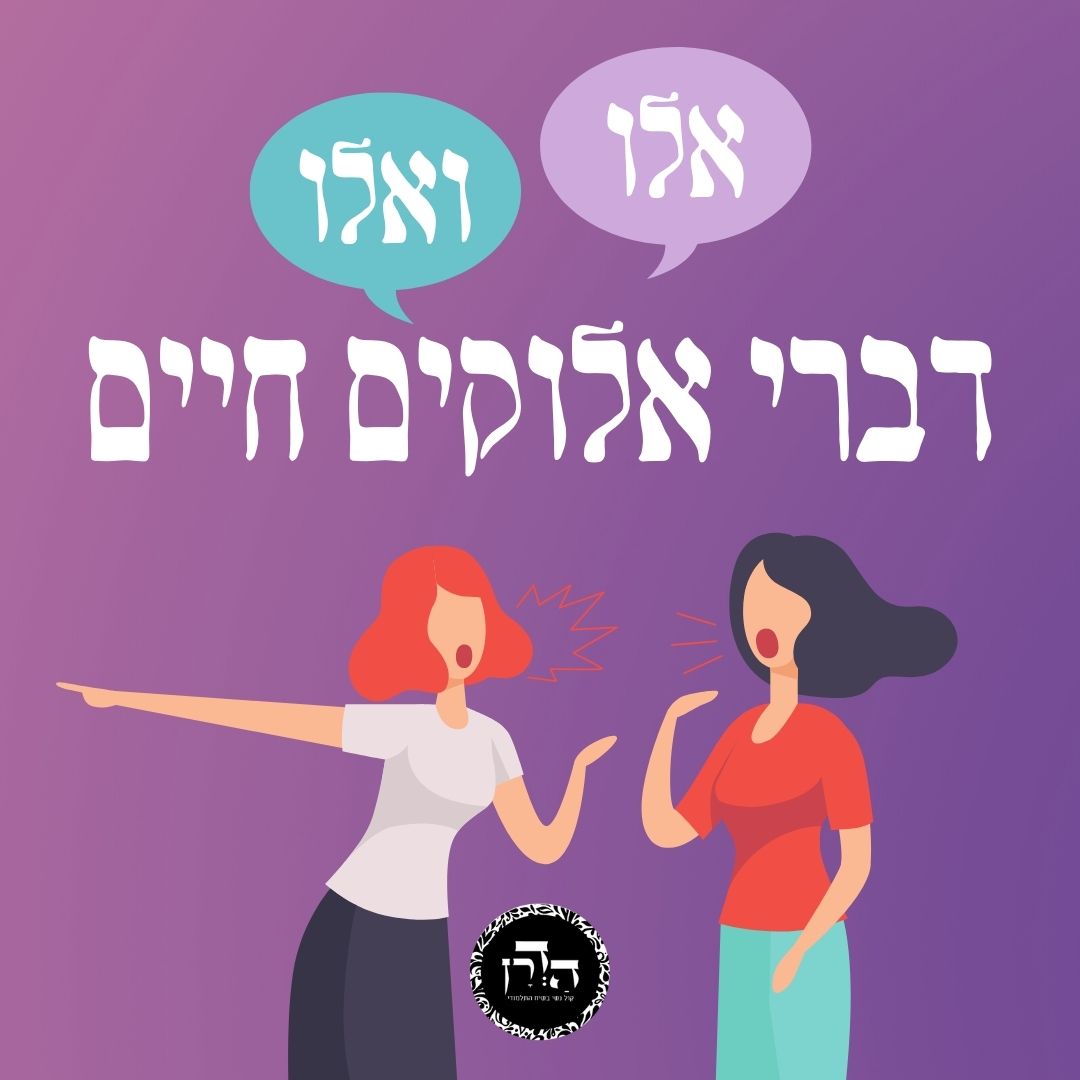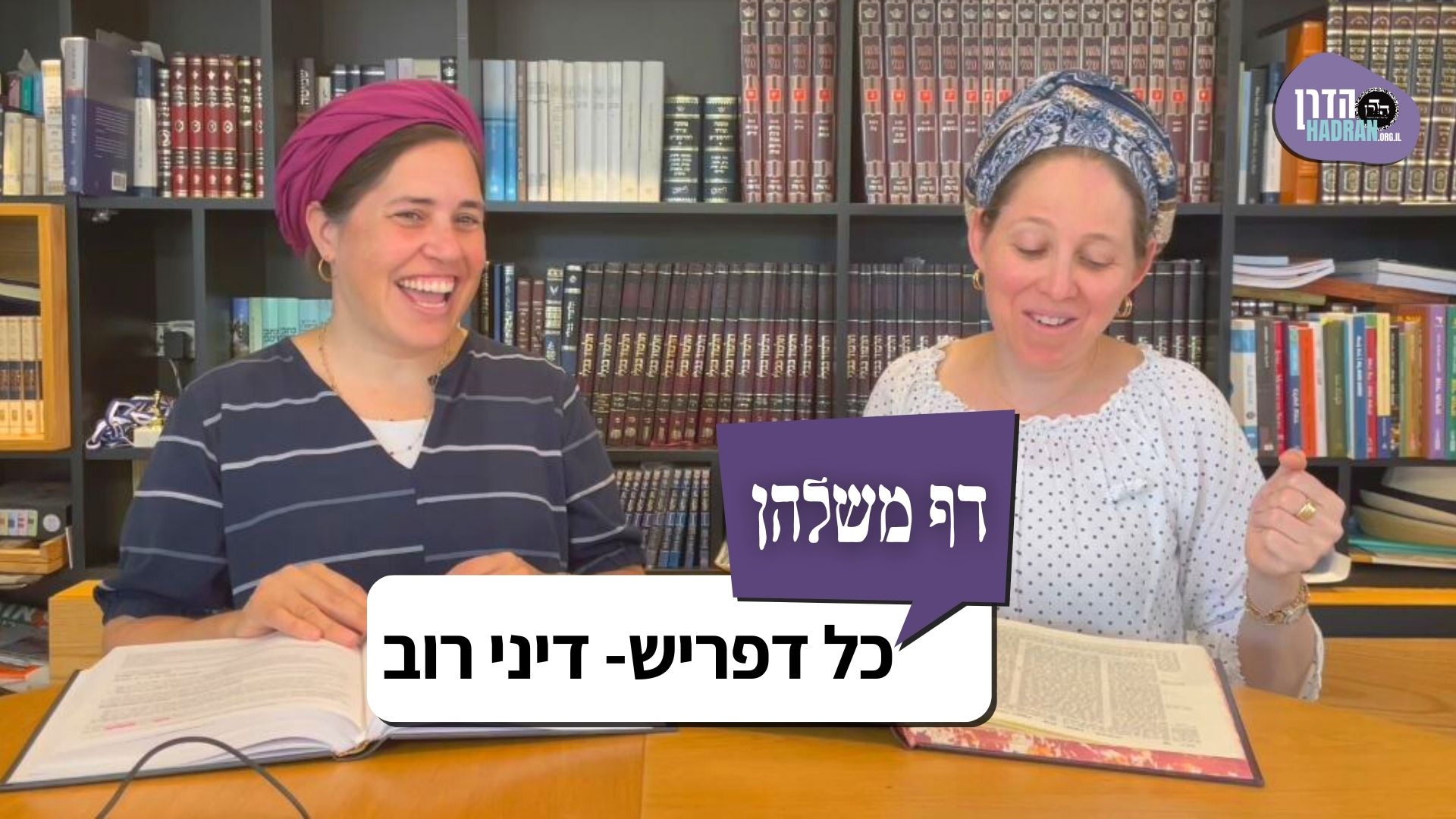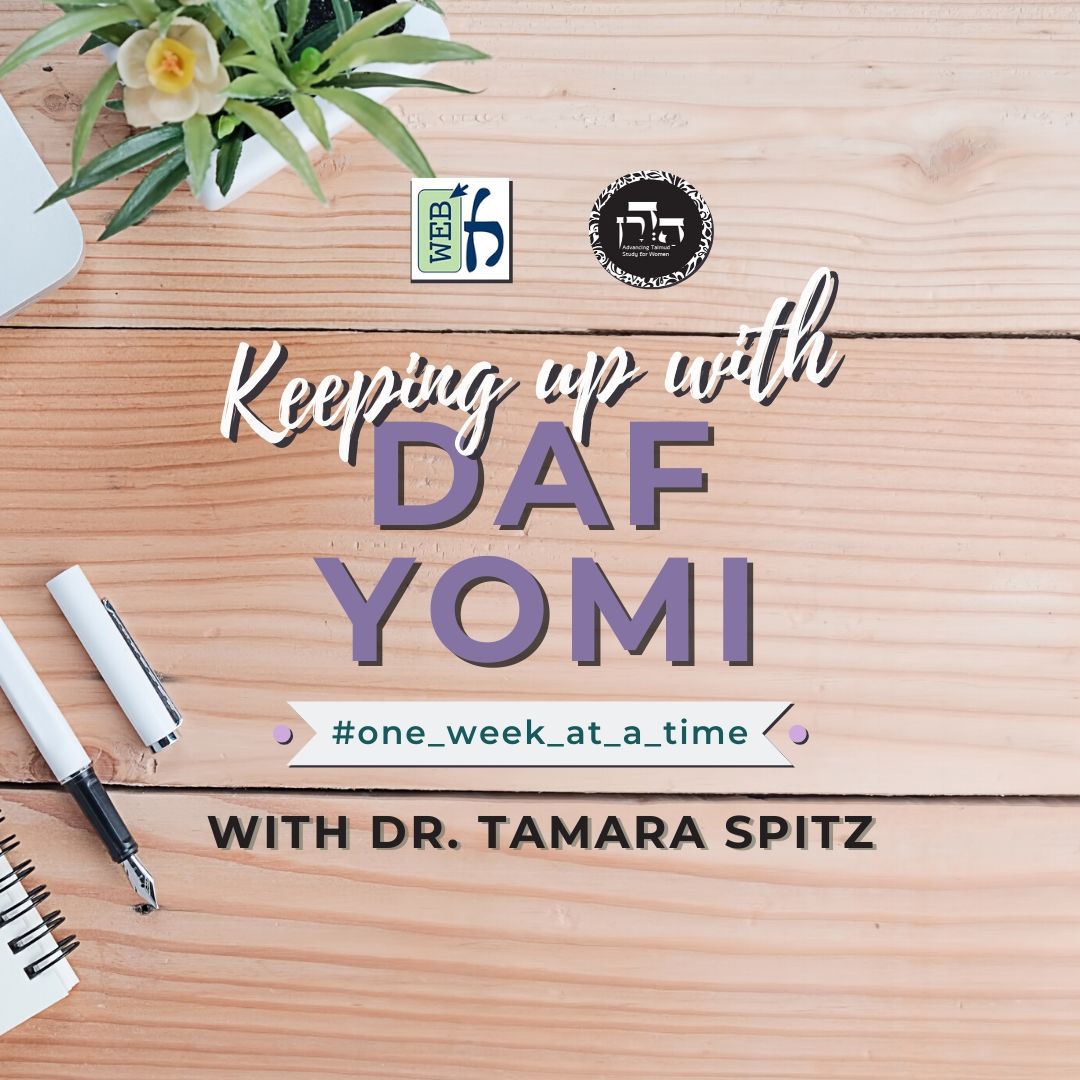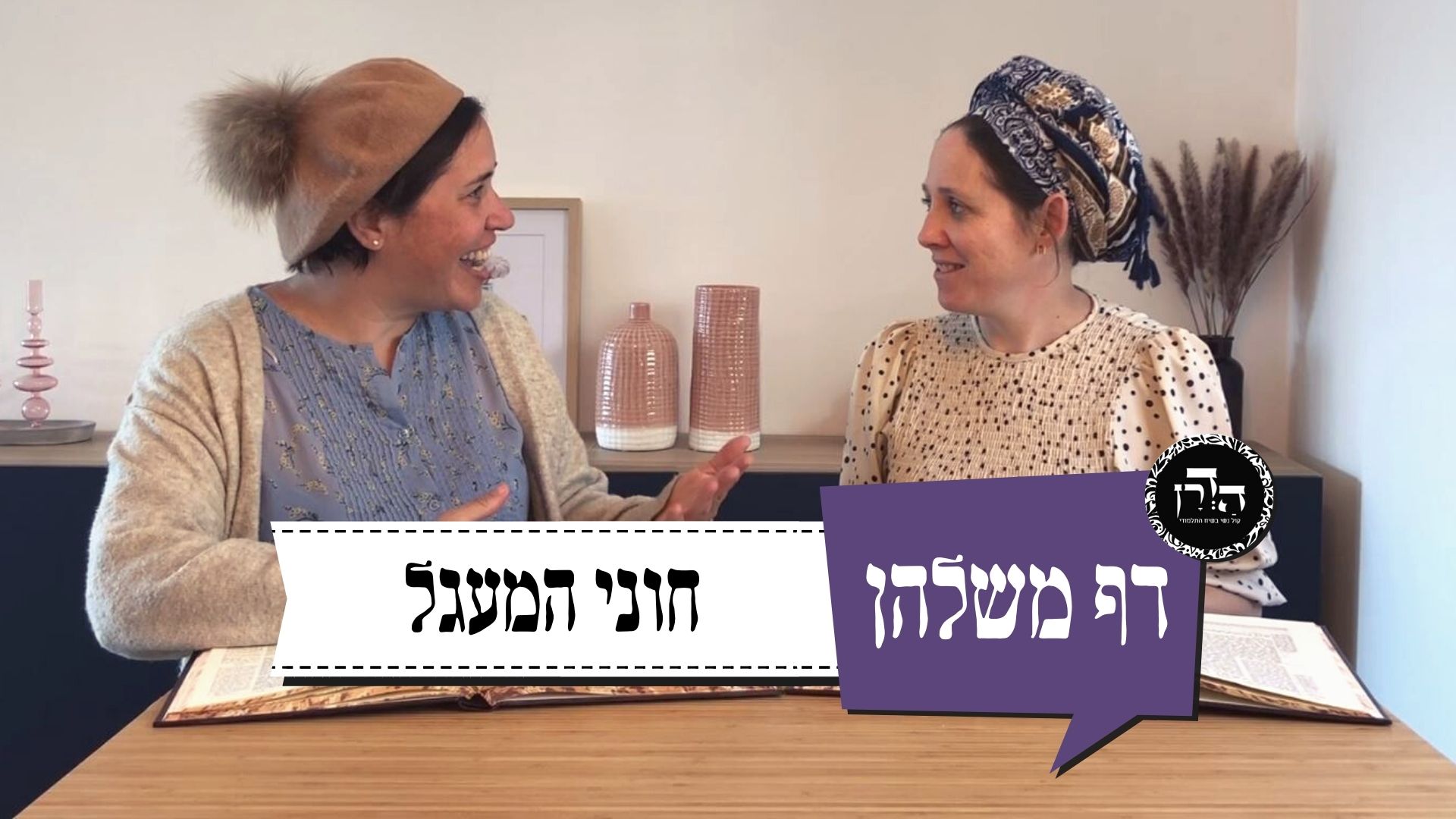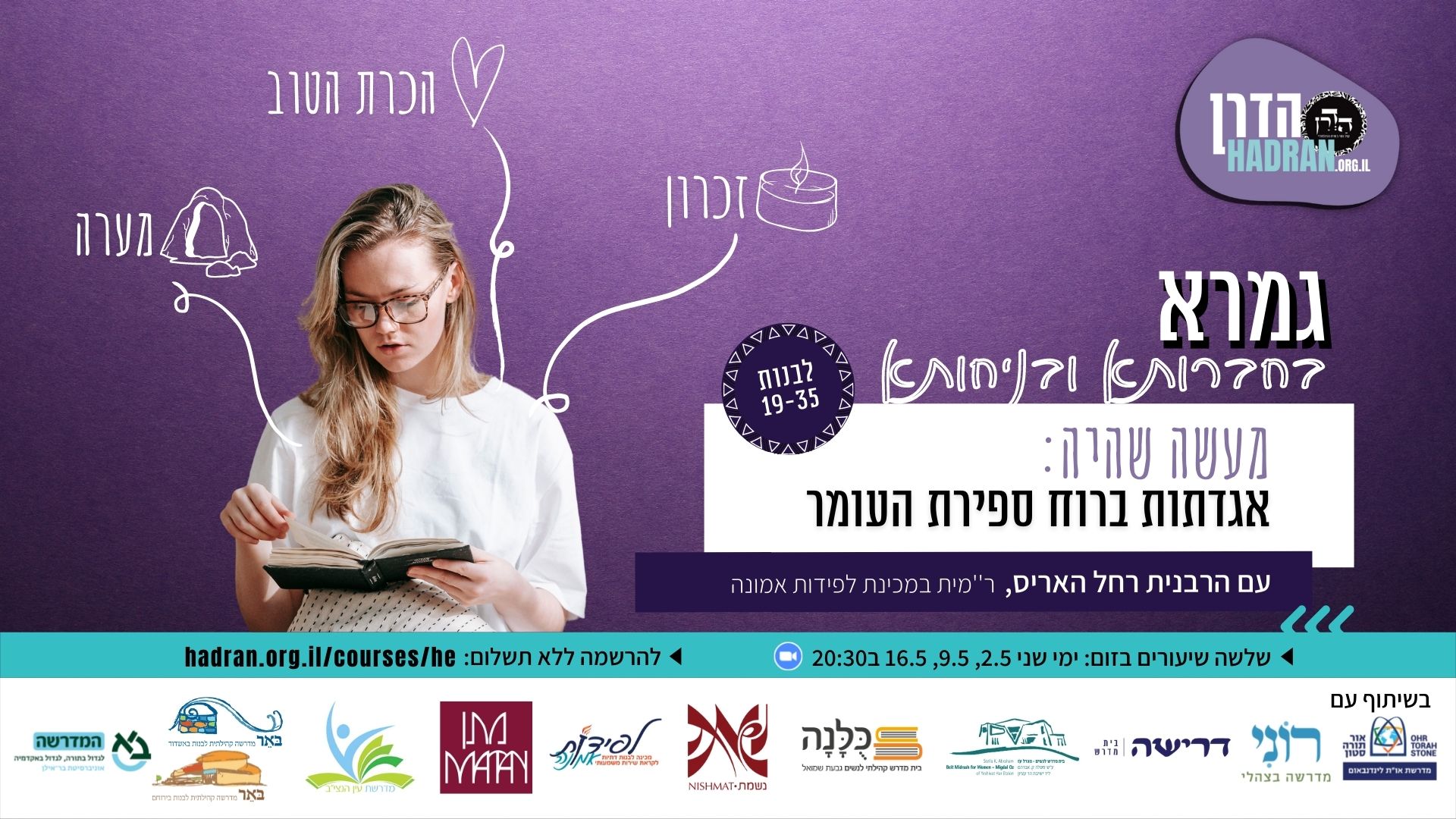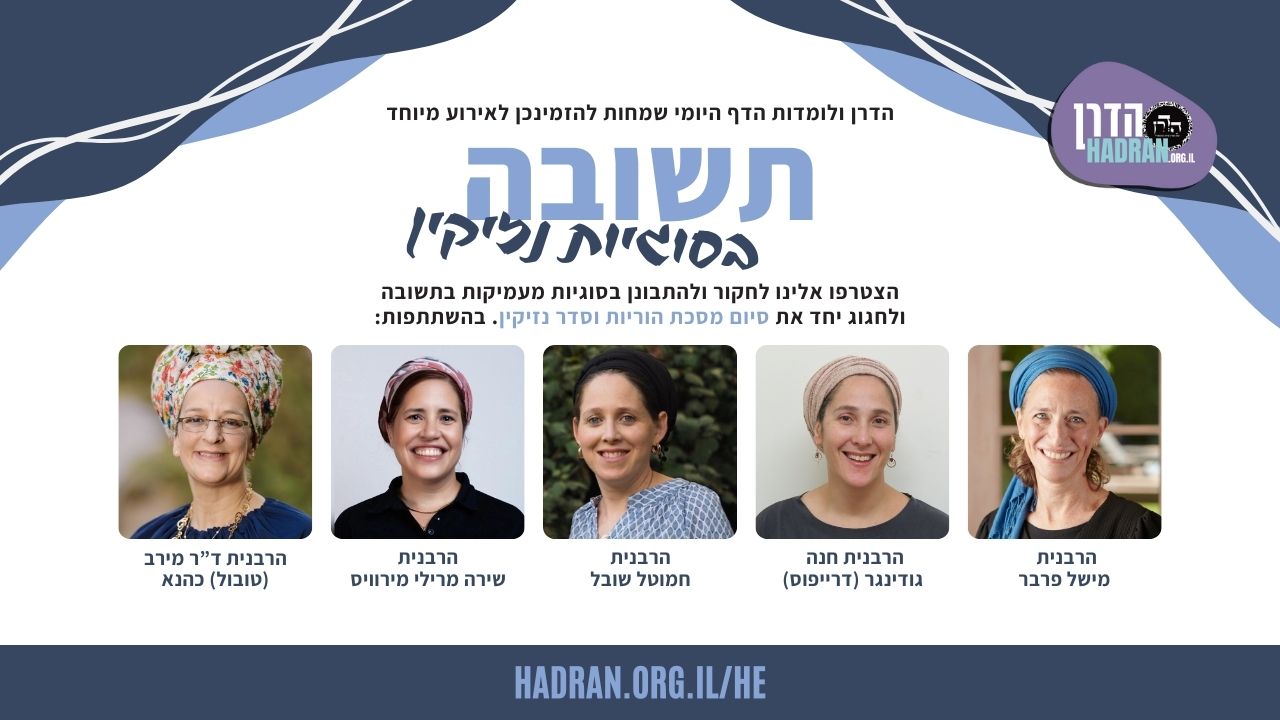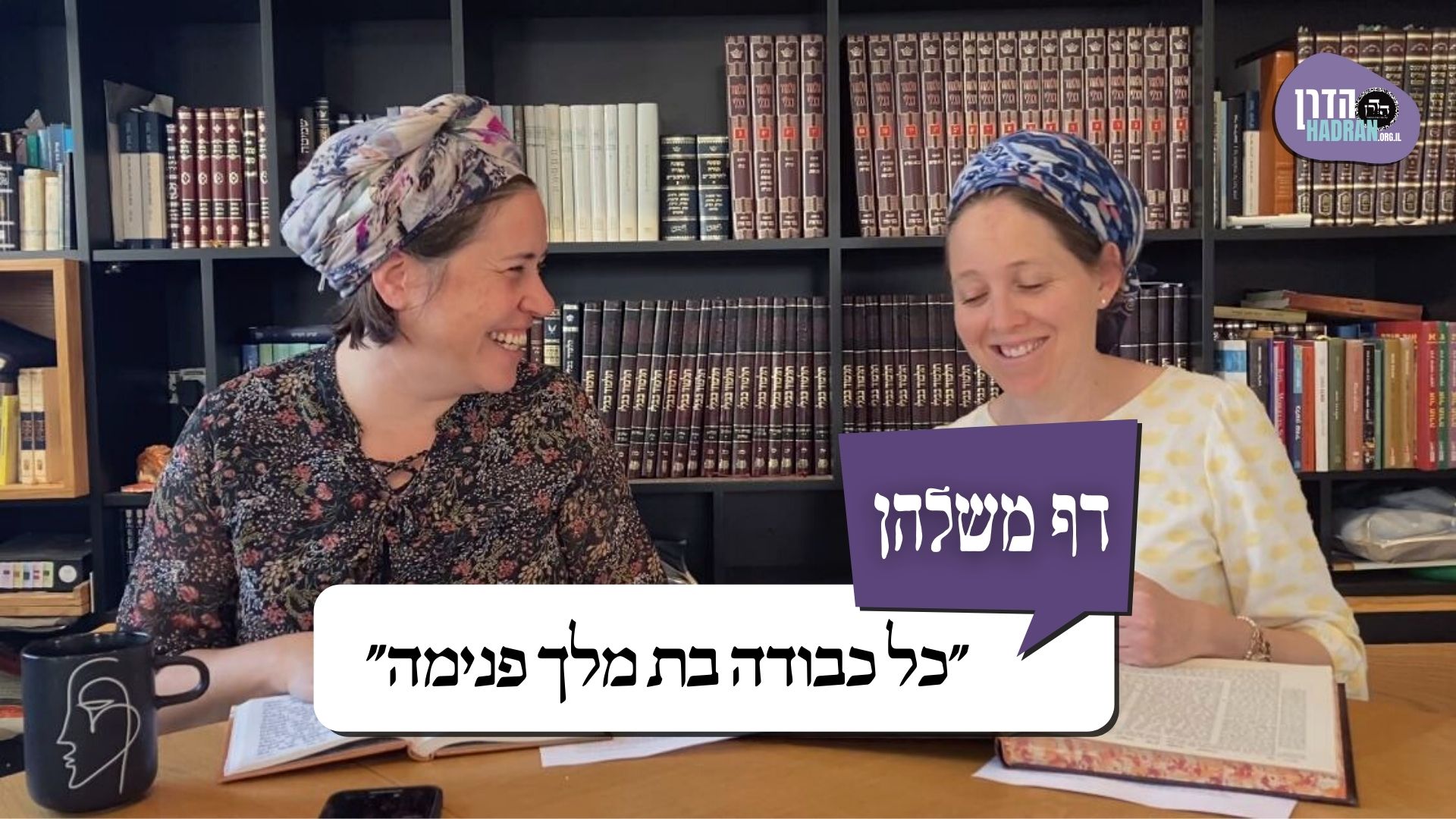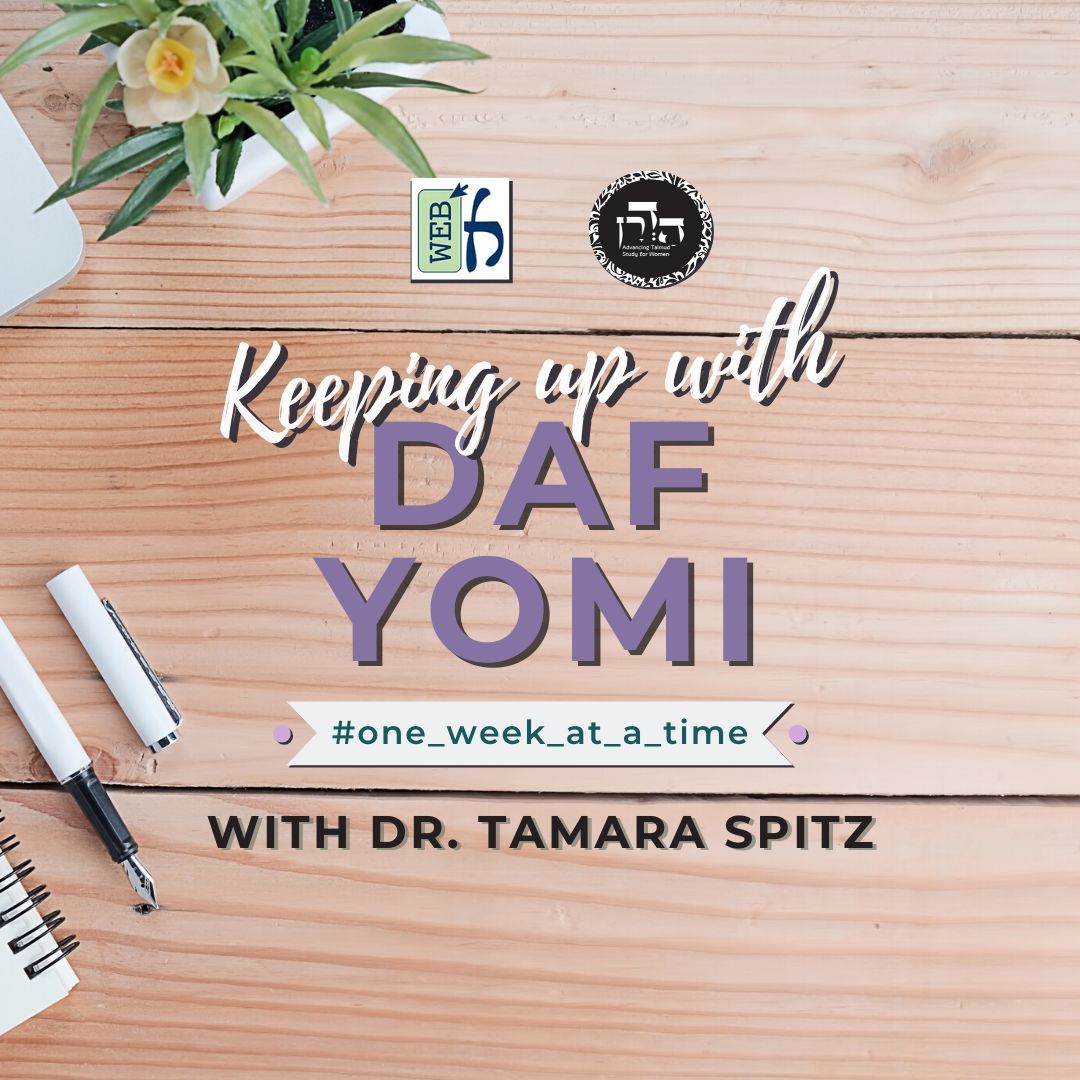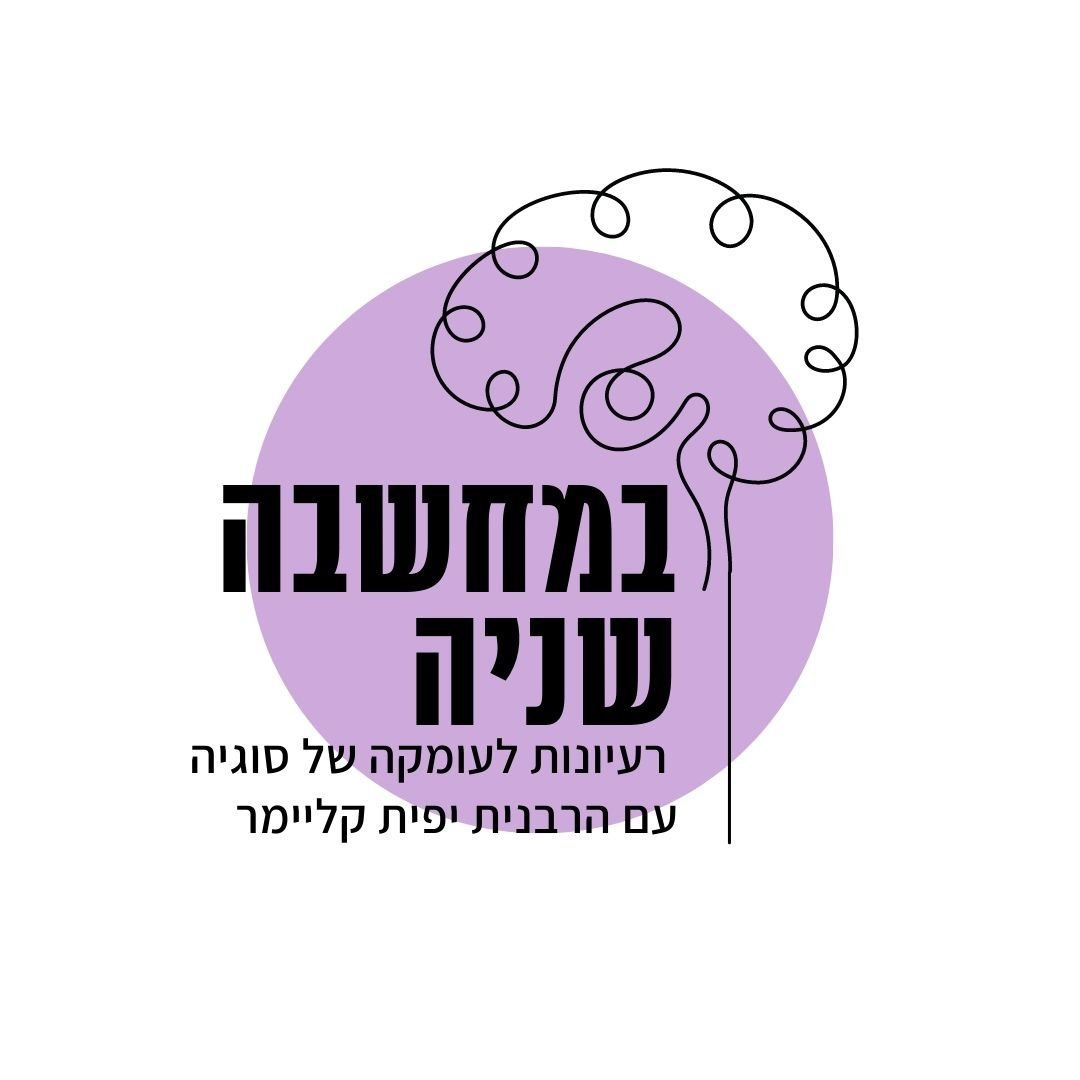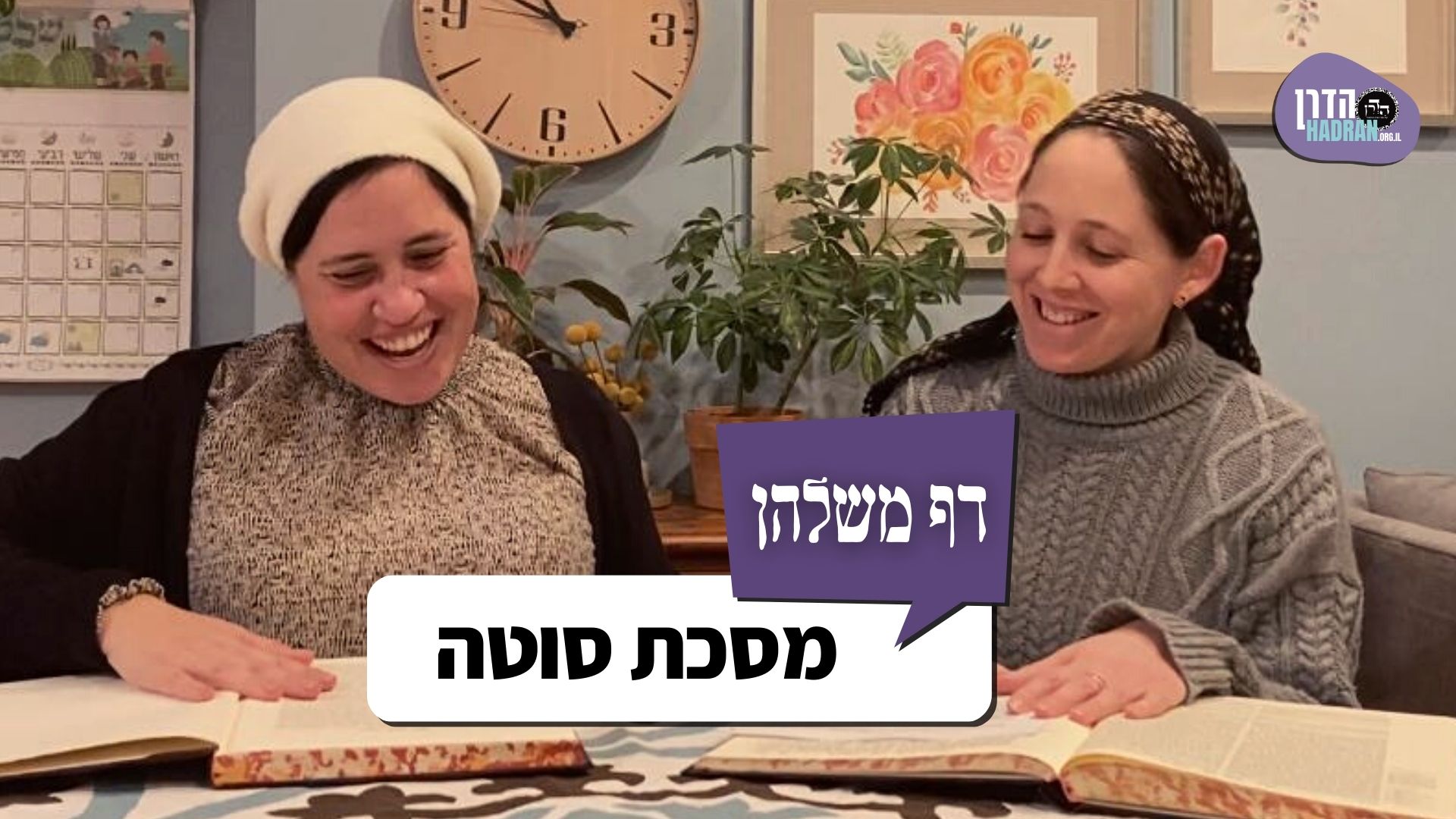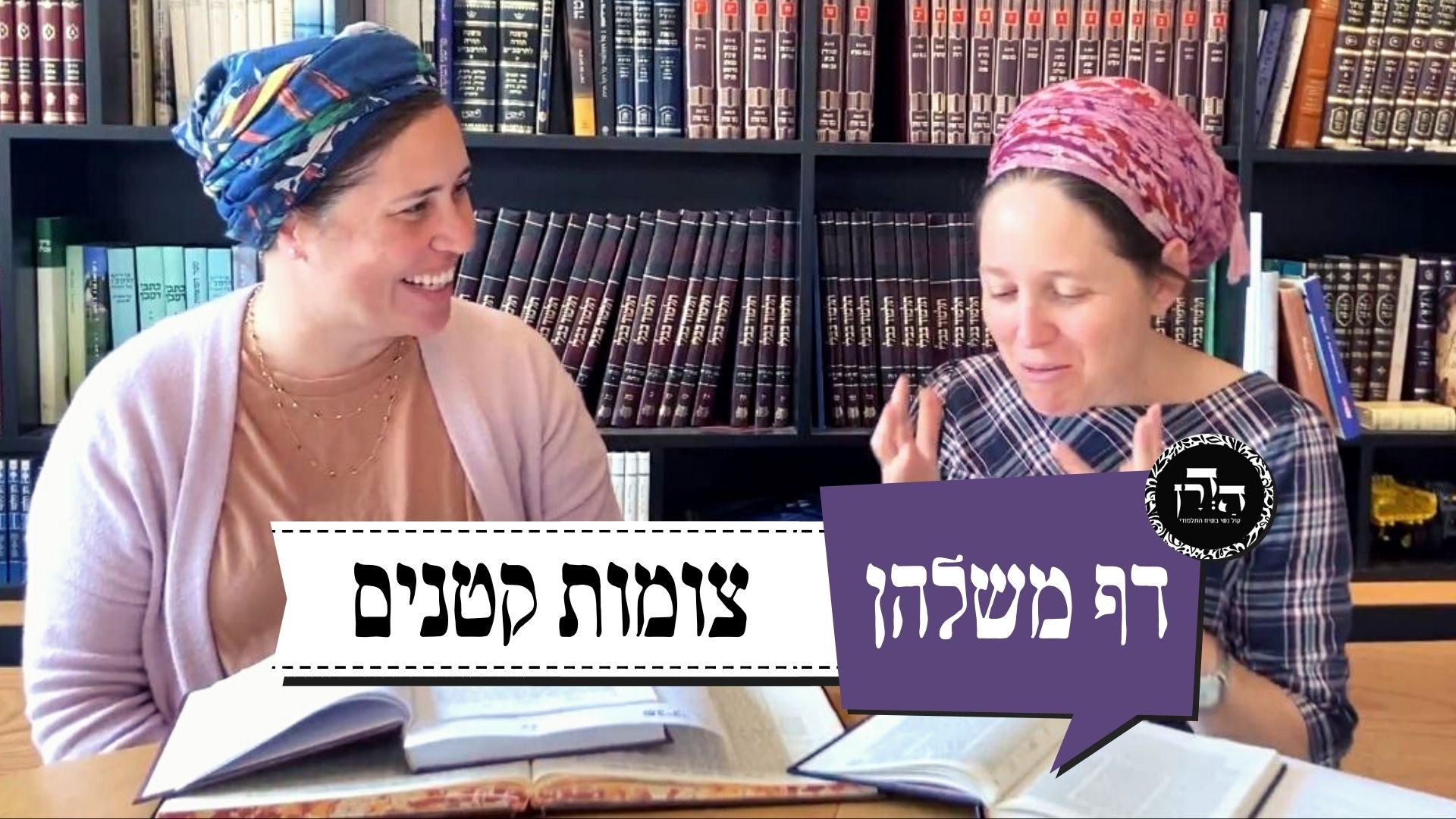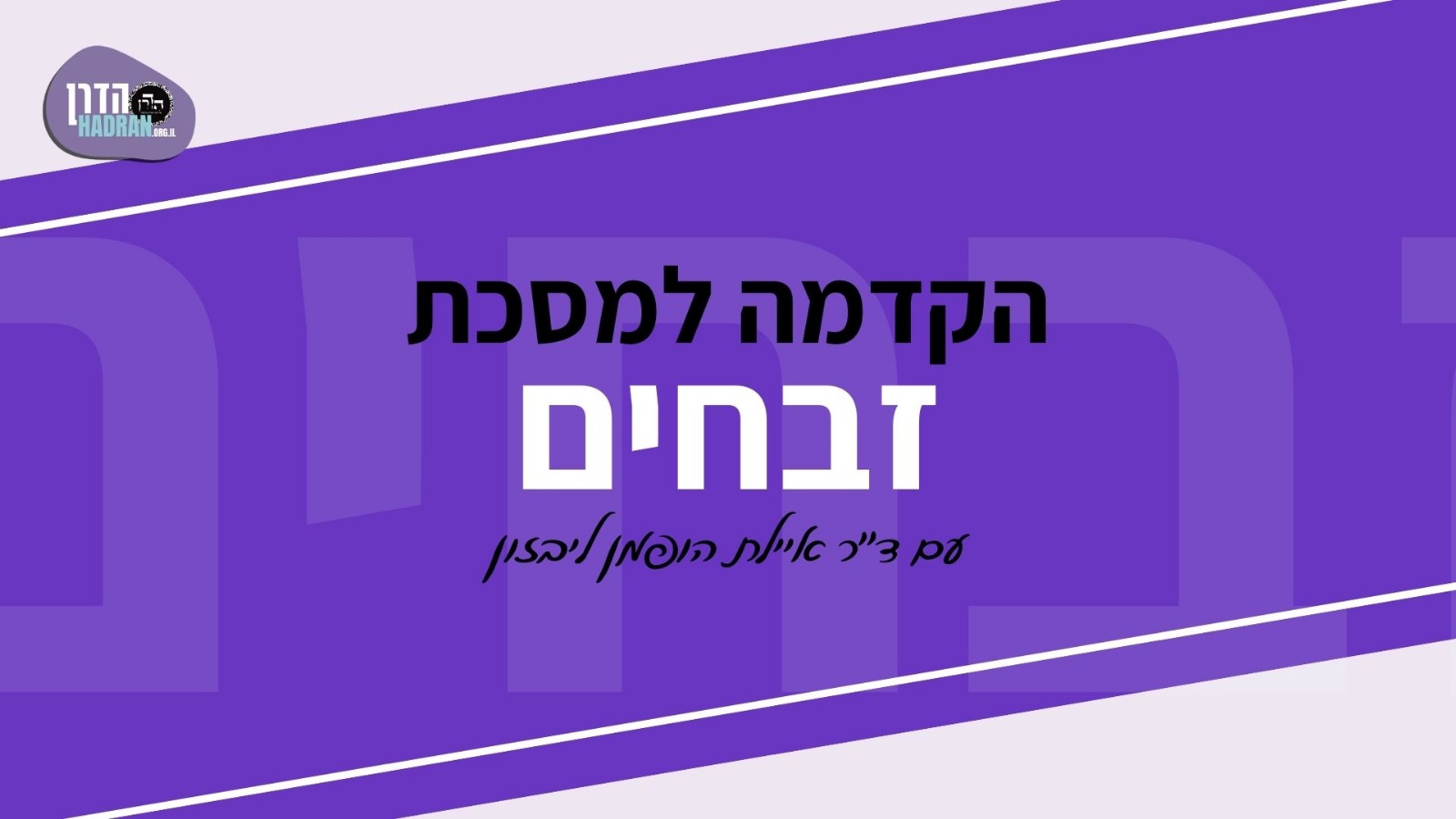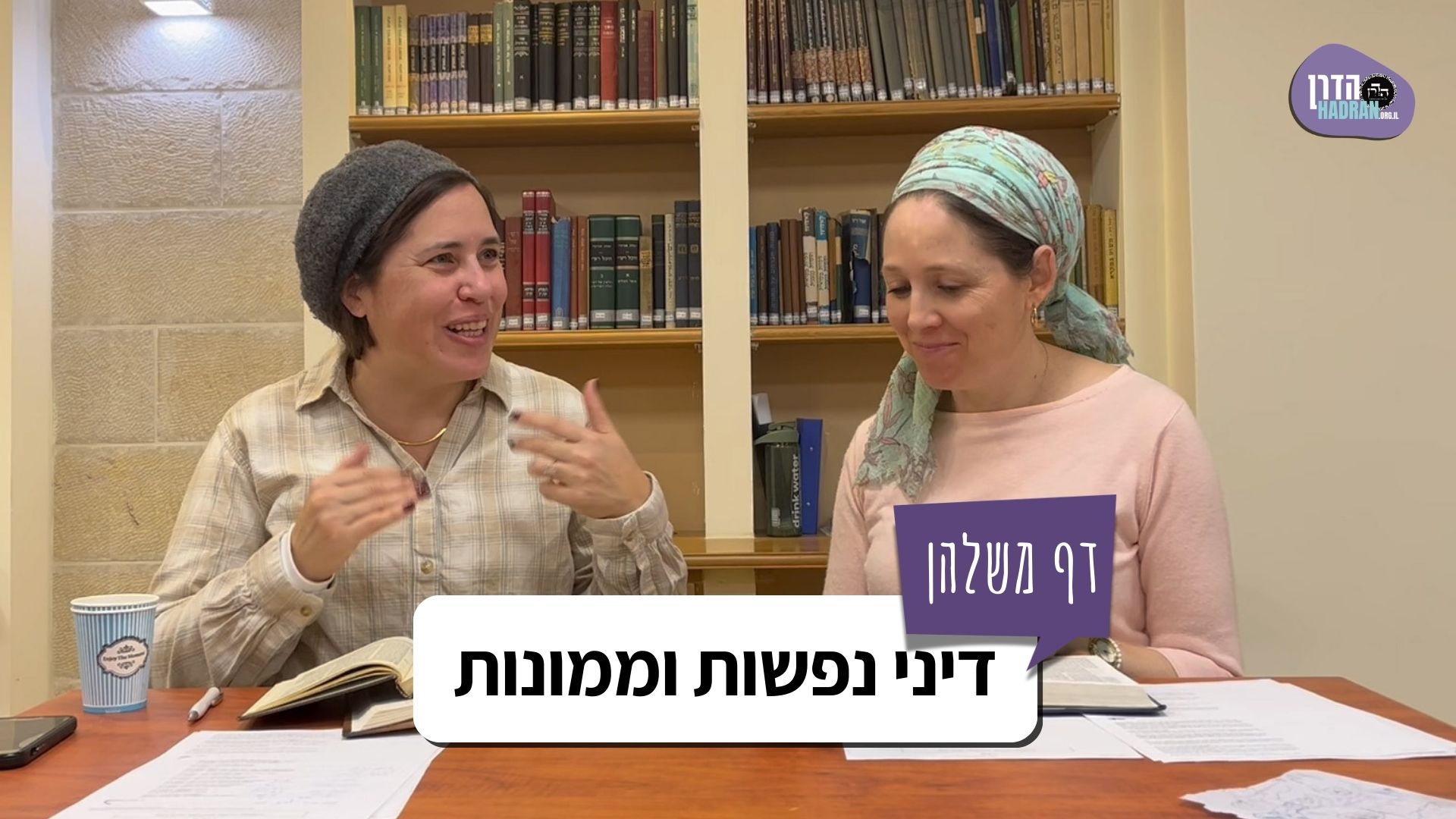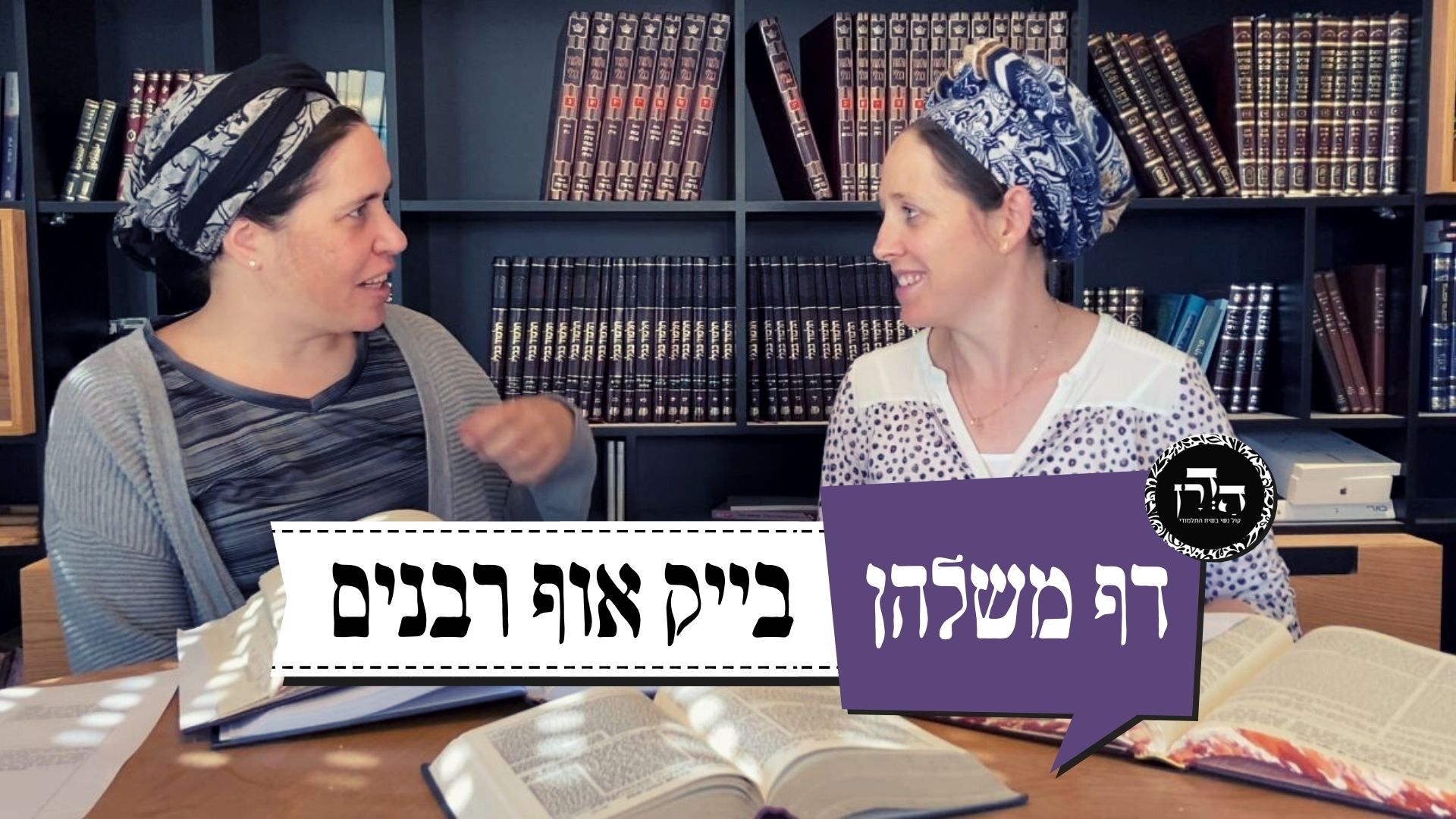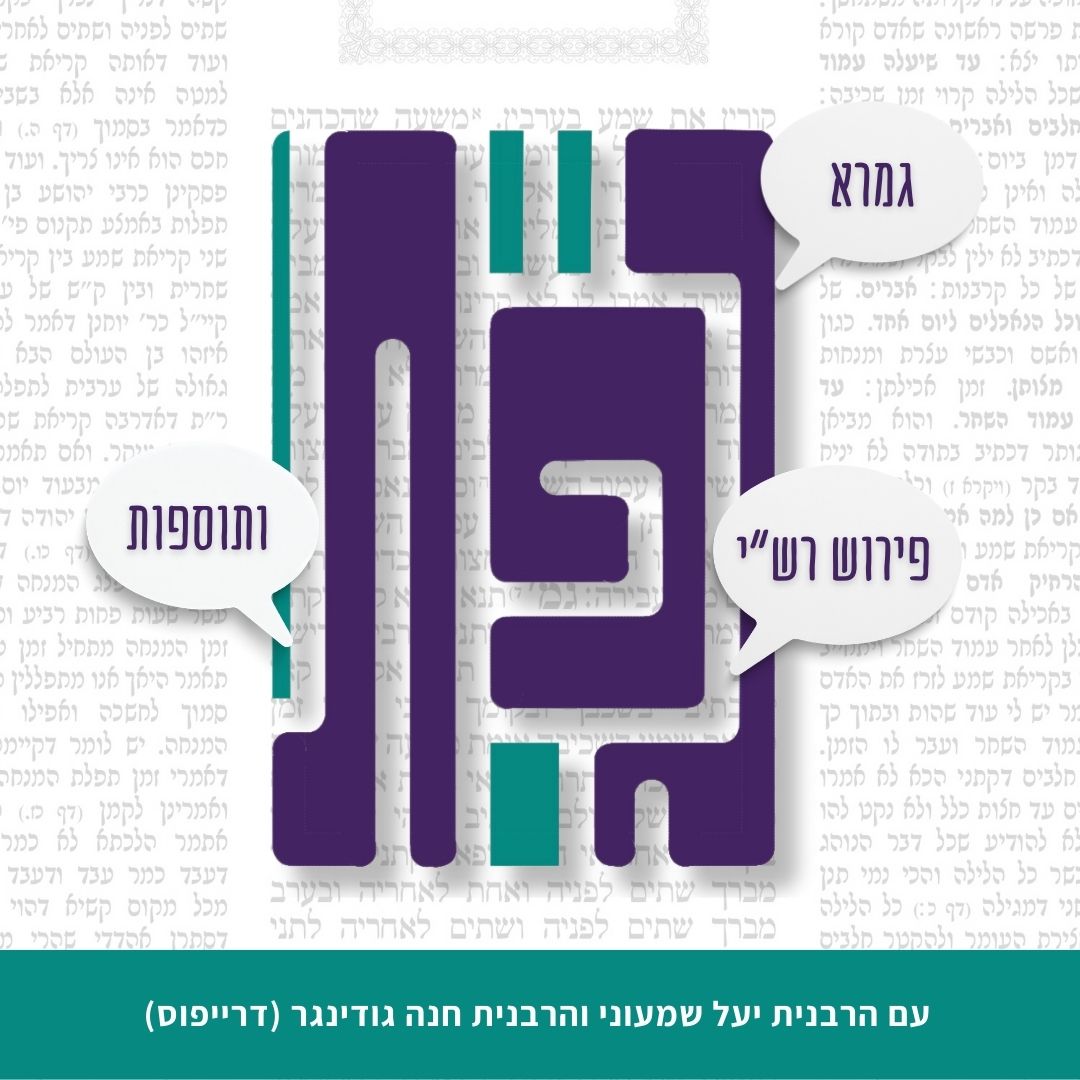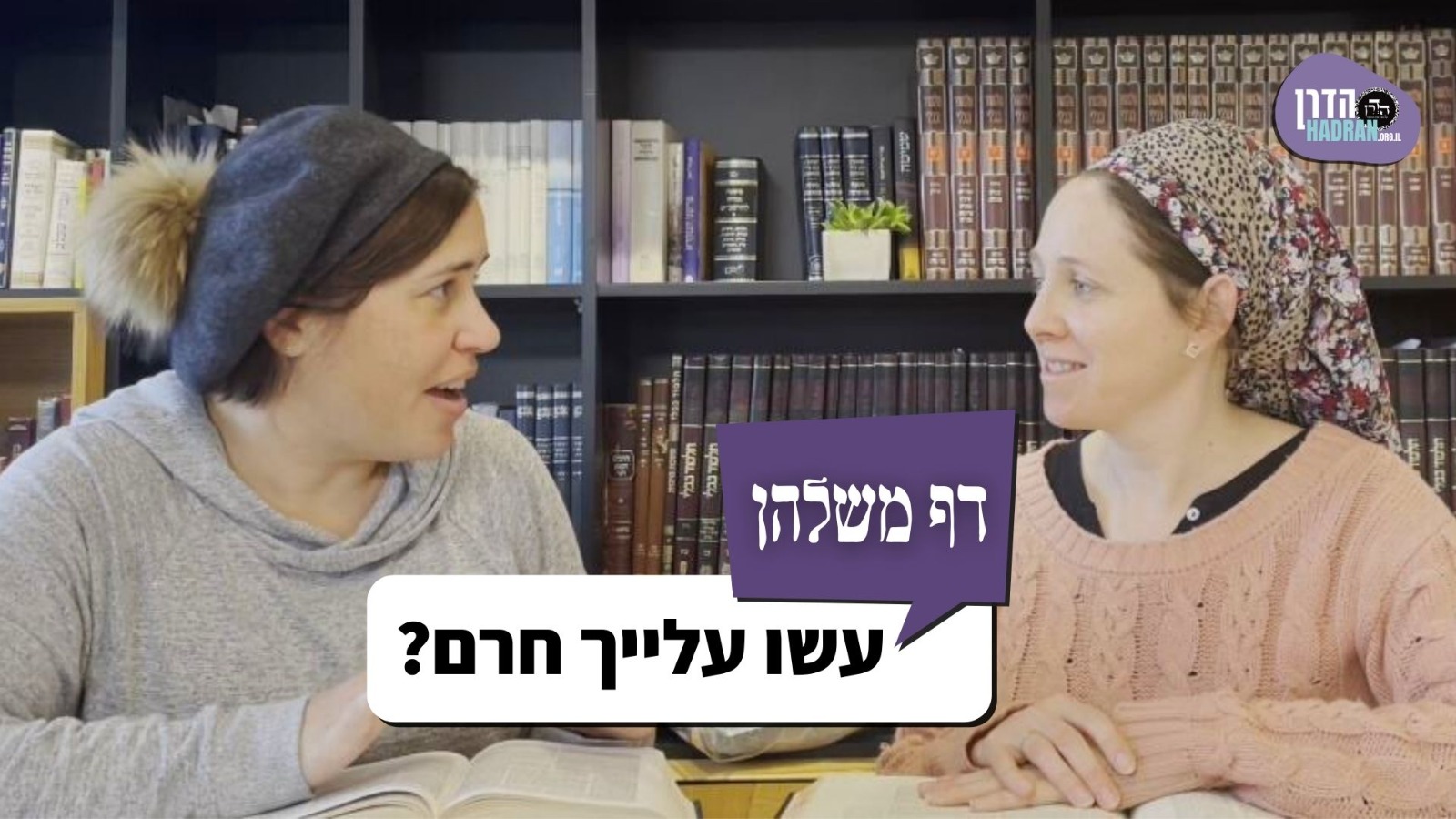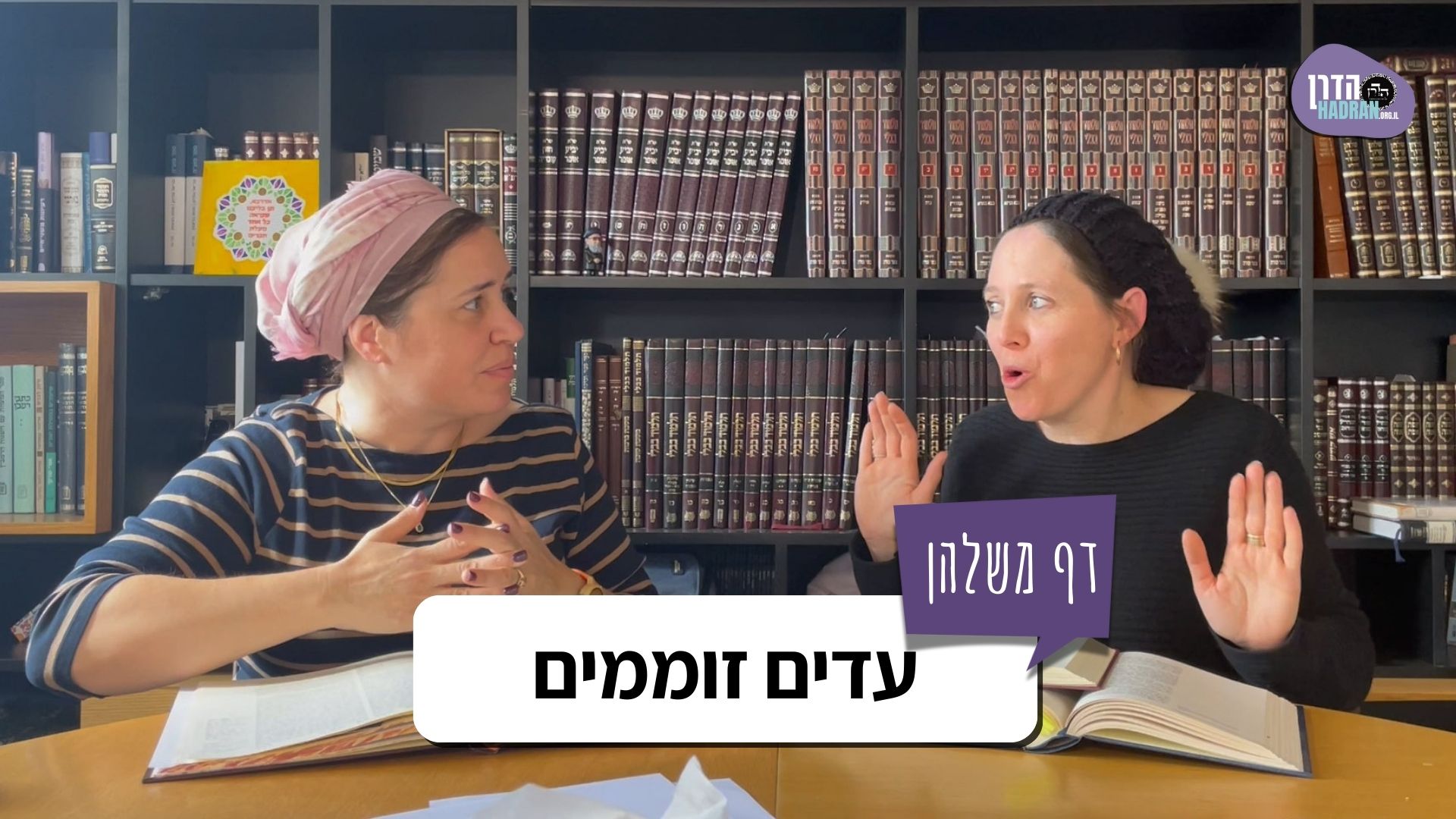רב אמר הדין לגבי בוגרת שונה ממה שכתוב במשנה. הגמרא מקשה עליו מברייתא. מישהו ניסה להורות כרב אבל טעה בהבנתו ובכך מת לפני שהיה הורה שלא כהלכה. כשנושרים שיניו של אדם, מתמעט מזונותיו. כמה זמן זה עונה? הגמרא מביא קושיה ממקור אחר ששם עונה מתפרש בצורה אחרת. רב ושמואל הורו נגד משתנינו שאדם בועל בעילת מצוה ופורש מיד מחשש מדם נידה. האם דם בתולים נראה שונה מדם בתולים ובכך קל יותר להבחין?
הלימוד השבוע מוקדש ע”י רוברט ופאולה כהן לע”נ יוסף בן משה הכהן ז”ל. יוסף היה חזן שאהב מאוד לשיר, עבד קשה בחייו והיה מאוד מסור למשפחתו ולקהילה.
רוצה להקדיש שיעור?

כלים
הלימוד השבוע מוקדש ע”י רוברט ופאולה כהן לע”נ יוסף בן משה הכהן ז”ל. יוסף היה חזן שאהב מאוד לשיר, עבד קשה בחייו והיה מאוד מסור למשפחתו ולקהילה.
כלים
העמקה
רוצה להבין מה באמת קורה מתחת לפני השטח של הסוגיה?
שיעורים, פודקאסטים והרחבות של מיטב המורות שלנו יפתחו לך עוד זוויות וכיווני חשיבה.
חדשה בלימוד הגמרא?
זה הדף הראשון שלך? איזו התרגשות עצומה! יש לנו בדיוק את התכנים והכלים שיעזרו לך לעשות את הצעדים הראשונים ללמידה בקצב וברמה שלך, כך תוכלי להרגיש בנוח גם בתוך הסוגיות המורכבות ומאתגרות.
פסיפס הלומדות שלנו
גלי את קהילת הלומדות שלנו, מגוון נשים, רקעים וסיפורים. כולן חלק מתנועה ומסע מרגש ועוצמתי.
נדה סה
״עַד שֶׁתִּחְיֶה הַמַּכָּה״ תְּנַן!
in accordance with the ruling of the mishna: The Sages give her four nights, then he should have given her longer, as we learned in the mishna that according to Beit Hillel the blood may be attributed to the torn hymen until the wound heals.
אֶלָּא דְּיָהֵיב לַהּ כּוּלְּהוּ בִּימֵי נַעֲרוּת — נַעֲרוּת שְׁנֵים עָשָׂר חֹדֶשׁ מִי אִיכָּא? וְהָא אָמַר שְׁמוּאֵל: אֵין בֵּין נַעֲרוּת לְבַגְרוּת אֶלָּא שִׁשָּׁה חֳדָשִׁים בִּלְבָד! וְכִי תֵימָא בְּצִיר מֵהָכִי הוּא דְּלֵיכָּא, הָא טְפֵי אִיכָּא — הָא ״בִּלְבָד״ קָאָמַר.
Rather, you will say that he gave her these four nights all during her days as a young woman. Are there twelve months when one has the status of a young woman? But didn’t Shmuel say: The difference in time between becoming a young woman and becoming a grown woman is only six months? And if you would say that Shmuel is saying that it is in less than six months that there is no transition from young woman to grown woman status, but there is such a transition in more than six months, as women develop differently, that is not so, as Shmuel said: Only, which indicates that the period is neither less nor more than six months.
אֶלָּא, דְּיָהֵיב לַהּ שְׁתַּיִם בִּימֵי קַטְנוּת וּשְׁתַּיִם בִּימֵי נַעֲרוּת, הָא בְּעָא מִינֵּיהּ רַב חִינָּנָא בַּר שֶׁלֶמְיָא מֵרַב: הִגִּיעַ זְמַנָּהּ לִרְאוֹת תַּחַת בַּעְלָהּ, מַהוּ?
Rather, you will suggest that Rabbi Yehuda HaNasi gave her two days during her days as a minor, and he gave her two days during her days as a young woman. This too is difficult, as Rav Ḥinnana bar Shelamya asked Rav: With regard to a young girl who married before she reached puberty, and then her time to see menstrual blood arrived while she was under the authority of her husband, what is the halakha? Does she have the four nights when the blood is considered to be from her torn hymen?
אֲמַר לֵיהּ: כׇּל בְּעִילוֹת שֶׁאַתָּה בּוֹעֵל — אֵינָן אֶלָּא אַחַת, וְהַשְּׁאָר מַשְׁלִימִין לְאַרְבָּעָה לֵילוֹת.
And Rav said to him: All the acts of intercourse that you engage in while she is still too young are considered as only one act of intercourse, and the remainder, i.e., three more acts of intercourse, complete the total number of four nights. If so, Rabbi Yehuda HaNasi could not have given her two nights as a minor, since at most those acts of intercourse count as one.
אֶלָּא, דְּיָהֵיב לַהּ אַחַת בִּימֵי קַטְנוּת, וּשְׁתַּיִם בִּימֵי נַעֲרוּת, וְאַחַת בִּימֵי בַּגְרוּת. אִי אָמְרַתְּ בִּשְׁלָמָא בּוֹגֶרֶת בְּעָלְמָא יָהֲבִינַן לַהּ טְפֵי, כִּי הֵיכִי דְּאַהֲנַי קַטְנוּת בִּימֵי נַעֲרוּת לְמִבְצַר לַהּ חֲדָא, אַהֲנַי נָמֵי נַעֲרוּת לְבַגְרוּת לְמִבְצַר לַהּ חֲדָא.
Rather, you will suggest that he gave her one night during her days as a minor, and two nights during her days as a young woman, and one night during her days as a grown woman. But this is also difficult: Granted, if you say that we generally give a grown woman more than one night, then one can understand why Rabbi Yehuda HaNasi gave her one night in this case: Just as all the acts of intercourse she engaged in as a minor have the effect to deduct one night for her days as a young woman, similarly all the acts of intercourse she engaged in while a young woman have the effect to deduct one night for her days as a grown woman, leaving her with one.
אֶלָּא אִי אָמְרַתְּ בּוֹגֶרֶת דְּעָלְמָא לָא יָהֲבִינַן לַהּ טְפֵי — לָא לִיתֵּב לַהּ אֶלָּא בְּעִילַת מִצְוָה, וְתוּ לָא!
But if you say that we generally do not give a grown woman more than one night, then in this case Rabbi Yehuda HaNasi should have given her as a grown woman only the one act of relations that consummate a marriage, which are a mitzva, i.e., merely a single act of intercourse, and nothing more, as otherwise the acts of intercourse before she became a grown woman would not have affected her status.
לְעוֹלָם, דְּיָהֵיב לַהּ אַחַת בִּימֵי קַטְנוּת וְשָׁלֹשׁ בִּימֵי נַעֲרוּת. מִי סָבְרַתְּ כֹּל תְּלָתָא יַרְחֵי — חֲדָא עוֹנָה? כֹּל תְּרֵי יַרְחֵי — חֲדָא עוֹנָה.
The Gemara answers: Actually, the correct explanation is that Rabbi Yehuda HaNasi gave her one night during her days as a minor and three nights during her days as a young woman. And as for the fact that she has the status of a young woman for only exactly six months, do you maintain that every three months was counted as one period of the husband’s absence, such that she had only two nights in six months? This is not the case. Rather, every two months was counted as one period, and therefore she had three nights during these six months when she could attribute the blood to her torn hymen.
מִנְיָמִין סַקְסְנָאָה הֲוָה שָׁקֵיל וְאָזֵיל לְאַתְרֵיהּ דִּשְׁמוּאֵל, סְבַר לְמֶעְבַּד עוֹבָדָא כְּוָותֵיהּ דְּרַב, אֲפִילּוּ רָאֲתָה. אֲמַר: לָא פָּלֵיג רַב בֵּין רָאֲתָה בֵּין לֹא רָאֲתָה.
The Gemara relates that the Sage Minyamin Saksana was coming and walking to the place of Shmuel. He thought that he would perform an action in accordance with the opinion of Rav, in that he would permit a grown woman to attribute blood to her torn hymen for the entire first night, even though she had already seen menstrual blood before she was married. Minyamin mistakenly said to himself: Rav does not distinguish between a woman who has seen menstrual blood and a woman who has not seen menstrual blood.
קְדֵים שְׁכֵיב בְּאוֹרְחָא, קָרֵי שְׁמוּאֵל עֲלֵיהּ דְּרַב ״לֹא יְאֻנֶּה לַצַּדִּיק כׇּל אָוֶן״.
Before Minyamin reached Shmuel’s place, he passed away on the road, and he never completed the journey. Upon hearing this, Shmuel recited this verse about Rav: “No mishap shall befall the righteous” (Proverbs 12:21), i.e., God does not allow prohibited acts to come from the statements of the righteous. In this case, Minyamin ruled incorrectly, based on a misunderstanding of Rav’s statement.
אָמַר רַב חִינָּנָא בַּר שֶׁלֶמְיָא מִשְּׁמֵיהּ דְּרַב: כֵּיוָן שֶׁנִּתְּקוּ שִׁנָּיו שֶׁל אָדָם, נִתְמַעֲטוּ מְזוֹנוֹתָיו, שֶׁנֶּאֱמַר: ״גַּם אָנֹכִי נָתַתִּי לָךְ נִקְיוֹן שִׁנַּיִם בְּכׇל עָרֵיכֶם וְחוֹסֶר לֶחֶם בְּכֹל מְקוֹמוֹתֵיכֶם״.
Since the Gemara cited Rav Ḥinnana bar Shelamya, it cites another of his statements: Rav Ḥinnana bar Shelamya said in the name of Rav: Once a person’s teeth fall out and he has difficulty eating, his food diminshes accordingly, as it is stated: “And I also have given you cleanness of teeth in all your cities, and lack of bread in all your places” (Amos 4:6). The term “cleanness of teeth” is here a euphemism for having no teeth at all, which leads to a lack of bread.
רָאֲתָה וְעוֹדָהּ. תָּנוּ רַבָּנַן: רָאֲתָה וְעוֹדָהּ בְּבֵית אָבִיהָ, בֵּית הִלֵּל אוֹמְרִים: כׇּל הַלַּיְלָה שֶׁלָּהּ, וְנוֹתְנִין לָהּ עוֹנָה שְׁלֵמָה. וְכַמָּה עוֹנָה שְׁלֵמָה? פֵּירֵשׁ רַבָּן שִׁמְעוֹן בֶּן גַּמְלִיאֵל: לַיְלָה וַחֲצִי יוֹם.
§ The mishna teaches: In the case of a young woman who saw menstrual blood before marriage, while she was still in her father’s house, Beit Hillel say: They may engage in several acts of intercourse, as any bleeding throughout the entire night is attributed to the torn hymen. The Sages taught in a baraita: In the case of a young woman who saw menstrual blood while she was still in her father’s house, Beit Hillel say: All the night is hers, and the Sages give her one complete period of time during which she may attribute all bleeding to her torn hymen. And how long is a complete period of time in this context? Rabban Shimon ben Gamliel explained that it is one night and half of the next day.
וּמִי בָּעֵינַן כּוּלֵּי הַאי? וּרְמִינְהִי: הֲרֵי שֶׁהָיוּ גִּתָּיו וּבֵית בַּדָּיו טְמֵאוֹת, וּבִקֵּשׁ לַעֲשׂוֹתָן בְּטָהֳרָה, כֵּיצַד הוּא עוֹשֶׂה? הַדַּפִּין וְהַלּוּלָבִין וְהָעֲדָשִׁין — מְדִיחָן,
The Gemara asks: But do we require all this time of one night and half of a day for a complete period? And the Gemara raises a contradiction from a baraita: In the case of one whose winepresses or olive presses were impure and he wished to prepare his grapes and olives in a state of ritual purity, how does he act? He should rinse the planks used to press the grapes in the winepress, and the palm branches used as brooms, and the troughs,
הָעֲקָלִים שֶׁל נְצָרִים וְשֶׁל בִּצְבּוּץ — מְנַגְּבָן, שֶׁל שִׁיפָא וְשֶׁל גֶּמִי — מְיַישְּׁנָן. וְכַמָּה מְיַישְּׁנָן? שְׁנֵים עָשָׂר חֹדֶשׁ. רַבָּן שִׁמְעוֹן בֶּן גַּמְלִיאֵל אוֹמֵר: מַנִּיחָן מִגַּת לַגַּת וּמִבַּד לְבַד.
and he should clean the pressing baskets with ashes and water if they were made of palm leaves or of hemp [bitzbutz], or leave them dormant if they were made of bast [shifa] or of reeds, because these absorb more of the wine. And how long must one leave them dormant? He must leave them for twelve months. Rabban Shimon ben Gamliel says: He can lay them aside from one wine-pressing season to the next wine-pressing season, or from one olive-pressing season to the next olive-pressing season.
הַיְינוּ תַּנָּא קַמָּא! אִיכָּא בֵּינַיְיהוּ חָרְפֵי וְאַפְלֵי.
The Gemara interrupts its citation to analyze the baraita: Rabban Shimon ben Gamliel’s statement is the same as that of the first tanna, as there are twelve months between one wine-pressing season and the next. The Gemara responds: The difference between them is the matter of the early and late ripening season for grapes. Rabban Shimon ben Gamliel does not require a precise measure of twelve months, as the difference in time between ripening seasons can be slightly more or less than that.
רַבִּי יוֹסֵי אוֹמֵר: הָרוֹצֶה לְטַהֵר מִיָּד, מַגְעִילָן בְּרוֹתְחִין אוֹ חוֹלְטָן בְּמֵי זֵיתִים. רַבָּן שִׁמְעוֹן בֶּן גַּמְלִיאֵל אוֹמֵר מִשּׁוּם רַבִּי יוֹסֵי: מַנִּיחָן תַּחַת הַצִּינּוֹר שֶׁמֵּימָיו מְקַלְּחִין, אוֹ בְּמַעְיָין שֶׁמֵּימָיו רוֹדְפִין. וְכַמָּה עוֹנָה? כְּדֶרֶךְ שֶׁאָמְרוּ בְּיֵין נֶסֶךְ, כָּךְ אָמְרוּ בִּטְהָרוֹת.
The Gemara continues its citation of the baraita. Rabbi Yosei says: One who wishes to purify the baskets immediately, without waiting a year, purges them in boiling water or scalds them in olive water. Rabban Shimon ben Gamliel says in the name of Rabbi Yosei: One sets them under a pipe whose water flows constantly or in a spring with rapid waters. And how much time should he leave them there? He should leave them for a period of time. In the same way that the Sages stated this time frame with regard to wine used for a libation in idol worship, so too the Sages stated this time frame with regard to matters of ritual purity.
כְּלַפֵּי לְיָיא! בִּטְהָרוֹת קָיְימִינַן! אֶלָּא, כְּדֶרֶךְ שֶׁאָמְרוּ בִּטְהָרוֹת, כָּךְ אָמְרוּ בְּיֵין נֶסֶךְ.
The Gemara expresses surprise at this last clause: Isn’t it the opposite [kelapei layya]? We are dealing with matters of purity in this baraita. Rather, the baraita means: In the same way that the Sages stated this time frame with regard to matters of ritual purity, so too the Sages stated this time frame in the case of wine used for a libation in idol worship.
וְכַמָּה עוֹנָה? אָמַר רַבִּי חִיָּיא בַּר אַבָּא אָמַר רַבִּי יוֹחָנָן: אוֹ יוֹם אוֹ לַיְלָה. רַבִּי חָנָה שְׁאוּנָא, וְאָמְרִי לַהּ רַבִּי חָנָה בַּר שְׁאוּנָא, אָמַר רַבָּה בַּר בַּר חַנָּה אָמַר רַבִּי יוֹחָנָן: חֲצִי יוֹם וַחֲצִי לַיְלָה.
The Gemara asks: And how long is the period of time referred to in the baraita? Rabbi Ḥiyya bar Abba says that Rabbi Yoḥanan says: Either the day or the night. Rabbi Ḥana She’ona, and some say Rabbi Ḥana bar She’ona, say that Rabba bar bar Ḥana says that Rabbi Yoḥanan says: Half a day and half a night.
וְאָמַר רַב שְׁמוּאֵל בַּר רַב יִצְחָק: וְלָא פְּלִיגִי — הָא בִּתְקוּפַת נִיסָן וְתִשְׁרִי, הָא בִּתְקוּפַת תַּמּוּז וְטֵבֵת.
And Rav Shmuel bar Rav Yitzḥak said: And the Sages do not disagree. The ruling of this one, who says either a day or a night, is stated with regard to the equinox of the season of Nisan or Tishrei, when the days and night are equal; whereas the ruling of that one, who says half a day and half a night, is stated with regard to the solstice of the season of Tammuz, i.e., summer, or Tevet, i.e., winter, which have the longest day or night respectively, so that half the day and half the night together amount to twelve hours. This baraita apparently contradicts the statement of Rabban Shimon ben Gamliel, who says that the woman may attribute the blood to her hymen for a night and half the day.
הָכָא נָמֵי, אֵימָא גַּבֵּי נִדָּה חֲצִי יוֹם וַחֲצִי לַיְלָה! וְהָא ״לַיְלָה וַחֲצִי יוֹם״ קָאָמַר! אֶלָּא: אִי לַיְלָה דְּנִיסָן וְתִשְׁרִי, אִי חֲצִי יוֹם וַחֲצִי לַיְלָה דְּטֵבֵת וְתַמּוּז.
The Gemara answers: Here too, one can say with regard to a menstruating woman that he meant half a day and half a night. The Gemara raises a difficulty. But Rabban Shimon ben Gamliel said a night and half a day. The Gemara clarifies: Rather, this is what Rabban Shimon ben Gamliel meant: Either a night during Nisan or Tishrei, which is twelve hours, or half a day and half a night during Tevet or Tammuz, which also equals twelve hours.
וְאִיבָּעֵית אֵימָא: שָׁאנֵי כְּתוּבָּה — דְּמַגְּהִי בַּהּ טְפֵי, עַד דְּחָתְמִי.
And if you wish, say instead: With regard to the purity of wine, a period is twelve hours. But in the case of marriage the time frame is different, due to the marriage contract, which is signed before the marriage is consummated, as there are those who delay for a lengthy period until they complete and sign it. Consequently, the Sages extended the period in this case to a night and half a day.
רָב וּשְׁמוּאֵל דְּאָמְרִי תַּרְוַיְיהוּ: הֲלָכָה — בּוֹעֵל בְּעִילַת מִצְוָה, וּפוֹרֵשׁ.
§ Although the mishna provides a certain period of time for both a minor and a young woman during which they may attribute any blood to the torn hymen, nevertheless Rav and Shmuel both say that the halakha is that the groom engages in relations that consummate a marriage, which are a mitzva, and then he separates from his wife.
מֵתִיב רַב חִסְדָּא: מַעֲשֶׂה וְנָתַן לָהּ רַבִּי אַרְבָּעָה לֵילוֹת מִתּוֹךְ שְׁנֵים עָשָׂר חֹדֶשׁ!
Rav Ḥisda raises an objection from the baraita: There was an incident involving a virgin who married, and Rabbi Yehuda HaNasi gave her four nights to engage in intercourse within twelve months of her wedding. This indicates that the husband does not have to separate from his wife immediately after the first act of intercourse is completed.
אֲמַר לֵיהּ רָבָא: הַדּוֹרֵי אַפִּירְכָא לְמָה לִי? אוֹתֵיב מִמַּתְנִיתִין! הוּא סָבַר: מַעֲשֶׂה רַב.
Rava said to Rav Ḥisda: Why do I need to search for a refutation from a baraita, which is not necessarily known by all? One can raise a difficulty from an explicit statement of the mishna, which states that the first blood a woman sees on her wedding night is attributed to her torn hymen. The Gemara explains that Rav Ḥisda raises his objection from the baraita, as he holds that a practical incident ruled upon by a Sage is a preferable source.
מִכׇּל מָקוֹם, לְרַב וּשְׁמוּאֵל קַשְׁיָא! אִינְהוּ דַּעֲבַדוּ כְּרַבּוֹתֵינוּ, דְּתַנְיָא: רַבּוֹתֵינוּ חָזְרוּ וְנִמְנוּ — בּוֹעֵל בְּעִילַת מִצְוָה וּפוֹרֵשׁ.
The Gemara returns to the objection: In any case, this baraita is difficult for Rav and Shmuel. The Gemara answers that they acted in accordance with the opinion attributed to our Sages, as it is taught in a baraita: Our Sages returned and were counted again, i.e., they voted and decided, that the groom engages in relations that consummate a marriage, which are a mitzva, and subsequently he separates from his wife.
אָמַר עוּלָּא: כִּי הָווּ בַּהּ רַבִּי יוֹחָנָן וְרֵישׁ לָקִישׁ בְּתִינוֹקֶת, לָא הֲווֹ מַסְּקִי מִינַּהּ אֶלָּא כִּדְמַסֵּיק תַּעֲלָא מִבֵּי כְרָבָא, וּמְסַיְּימִי בַּהּ הָכִי: בּוֹעֵל בְּעִילַת מִצְוָה וּפוֹרֵשׁ.
The Gemara proves that this ruling of Rav and Shmuel, based on the baraita, is also the opinion of Rabbi Yoḥanan and Reish Lakish. Ulla said: When we were learning the topic of a young girl who saw blood on her wedding night with Rabbi Yoḥanan and Reish Lakish, they brought up from it only the amount of earth that the fox brings up from a plowed field, i.e., they did not establish the halakha as stated in the mishna. And they concluded the discussion in this manner: The groom engages in relations that consummate a marriage, which are a mitzva, and then he separates from his wife.
אָמַר לוֹ רַבִּי אַבָּא לְרַב אָשֵׁי: אֶלָּא מֵעַתָּה, בַּעַל נֶפֶשׁ לֹא יִגְמוֹר בִּיאָתוֹ! אָמַר לוֹ: אִם כֵּן, לִבּוֹ נוֹקְפוֹ וּפוֹרֵשׁ.
Rabbi Abba said to Rav Ashi, in light of this ruling that the groom must separate from his bride after completing the act of intercourse: If that is so, a pious person should not complete his act of intercourse, lest he unintentionally continue longer than is permitted. Rav Ashi said to him in reply: The Sages did not issue such a decree, because if so, his heart will strike him with fear that perhaps his wife will begin to bleed while he is engaged in the act of intercourse, and he will separate from his wife completely and will not consummate the marriage.
תָּנוּ רַבָּנַן: וְכוּלָּן שֶׁהָיוּ שׁוֹפְעוֹת דָּם וּבָאוֹת, מִתּוֹךְ אַרְבָּעָה לֵילוֹת לְאַחַר אַרְבָּעָה לֵילוֹת, מִתּוֹךְ הַלַּיְלָה לְאַחַר הַלַּיְלָה — כּוּלָּן צְרִיכוֹת לִבְדּוֹק אֶת עַצְמָן.
§ The mishna teaches that a young girl is given four nights during which any bleeding is attributed to her torn hymen. The Sages taught in a baraita: And with regard to all of them, i.e., all the women who are given four nights, if they were discharging blood continually, from four nights until after those four nights, or in the case of those women who are given only one night, if they discharge blood from that one night until after that night, they may not attribute the blood to the torn hymen. Rather, all of them must examine themselves, in the manner that will be explained.
וּבְכוּלָּן, רַבִּי מֵאִיר מַחְמִיר כְּדִבְרֵי בֵּית שַׁמַּאי.
And with regard to all of these women, Rabbi Meir is stringent in accordance with the statement of Beit Shammai, and therefore a minor girl who bleeds for more than four nights must examine herself, despite the fact that Beit Hillel say she remains ritually pure until the wound has healed. Similarly, Rabbi Meir holds that with regard to a young girl who has reached puberty, if she continues to bleed after the first night she must examine herself.
וּשְׁאָר רְאִיּוֹת שֶׁבֵּין בֵּית שַׁמַּאי וּבֵית הִלֵּל — הַלֵּךְ אַחַר מַרְאֵה דָמִים.
The baraita continues: But with regard to the other cases of seeing blood, when she does not discharge blood continuously but bleeds again the following day, concerning which there is a dispute between Beit Shammai and Beit Hillel, Rabbi Meir holds that one follows the appearance of the blood. In other words, he does not maintain entirely in accordance with the opinion of Beit Shammai. Beit Hillel rule that the woman is ritually pure even if the color of the blood has changed, whereas Beit Shammai hold that she is ritually impure even if the color of the blood has not changed.
שֶׁהָיָה רַבִּי מֵאִיר אוֹמֵר: מַרְאֵה דָמִים מְשׁוּנִּים הֵן זֶה מִזֶּה. כֵּיצַד? דַּם נִדָּה — אָדוֹם, דַּם בְּתוּלִים — אֵינוֹ אָדוֹם. דַּם נִדָּה — זִיהוּם, דַּם בְּתוּלִים — אֵינוֹ זִיהוּם. דַּם נִדָּה — בָּא מִן הַמָּקוֹר, דַּם בְּתוּלִים — בָּא מִן הַצְּדָדִין.
As Rabbi Meir would say: The appearances of impure and pure blood differ from one another. How so? The blood of a menstruating woman is red, whereas blood that comes from a torn hymen, indicating that she was a virgin, is not red. The blood of a menstruating woman is cloudy; blood that indicates that she was a virgin is not cloudy. Finally, the blood of a menstruating woman comes from the uterus; blood that indicates that she was a virgin comes from the sides of the vaginal wall.
אָמַר רַבִּי יִצְחָק בַּר רַבִּי יוֹסֵי, אָמַר רַבִּי יוֹחָנָן: זוֹ דִּבְרֵי רַבִּי מֵאִיר, אֲבָל חֲכָמִים אוֹמְרִים כׇּל מַרְאֵה דָמִים אַחַת הֵן.
Rabbi Yitzḥak bar Rabbi Yosei says that Rabbi Yoḥanan says: This is the statement of Rabbi Meir. According to Rabbi Meir, it is possible to examine the color of blood to determine whether it is menstrual blood or hymenal blood. But the Rabbis say that all appearances of blood are one, i.e., there is no distinction between the appearance of menstrual blood and blood indicating one’s loss of virginity.
תָּנוּ רַבָּנַן: הָרוֹאָה דָּם מֵחֲמַת תַּשְׁמִישׁ — מְשַׁמֶּשֶׁת פַּעַם רִאשׁוֹנָה, וּשְׁנִיָּה, וּשְׁלִישִׁית, מִכָּאן וְאֵילָךְ — לֹא תְּשַׁמֵּשׁ עַד שֶׁתִּתְגָּרֵשׁ
§ The Sages taught in a baraita: A woman who sees blood due to sexual intercourse may engage in intercourse before the first time this occurs, before the second time this occurs, and before the third time this occurs. From this point forward, i.e., after three consecutive occurrences of bleeding due to intercourse, she may not engage in intercourse until she is divorced from her husband
